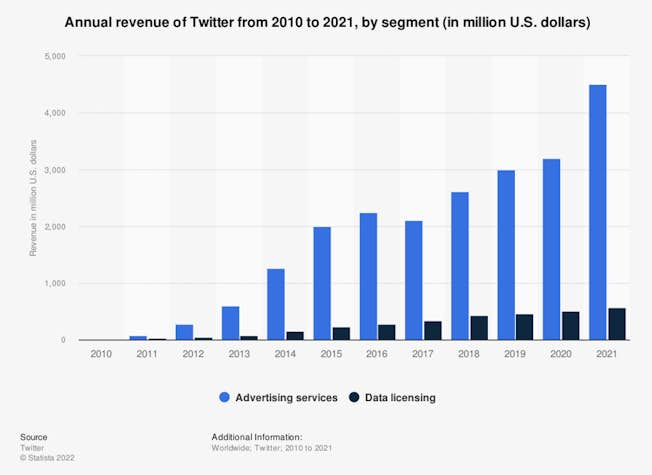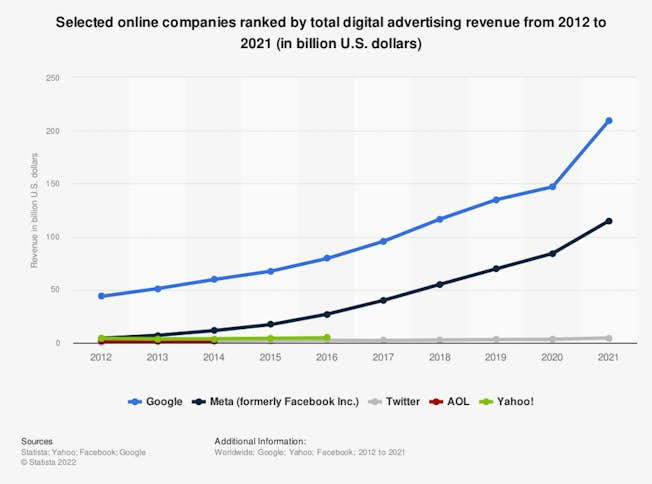Nov 20, 2022
How Will Twitter Change: 3 Possible Scenarios
The takeover of Twitter by Elon Musk has been, shall we say, eventful. Unfortunately for Musk, brands prefer stability to eventfulness when allocating their advertising budgets.
Twitter is not the biggest advertising platform, but it still plays an important role in any brand’s marketing strategy. Naturally, brands that already invest in Twitter marketing are wondering what might come next. In this article, we will lay out the facts so far and then hypothesize about some potential future scenarios - and what advertisers should do to prepare for each.
How will Elon change Twitter? The story so far
Elon Musk closed his takeover of Twitter on October 27th for $44 billion, after repeatedly trying to pull out of the deal. Since then, he has laid off thousands of staff and many others have opted to leave the company after Musk demanded they sign a ‘loyalty oath’.
His big idea so far has been the addition of a new subscription service for verified accounts at $8 per month. After a string of parody accounts paid the fee and then imitated major brands, Musk delayed the service’s launch. These actions had a material effect: the pharmaceutical firm Eli Lilly’s stock price fell 4% after a parody account pretending to be the company’s official handle tweeted that “insulin is free”.
Industry analysts are left wondering what strategy underpins Musk’s actions, if there is a strategy at all. It is likely that Musk is taking the approach that has worked for him at Tesla and applying it to a radically different business.
Famously, Tesla does not pay for advertising. In its company accounts, marketing costs are listed as “immaterial”. Indeed, Musk tweeted in 2019, “Tesla does not advertise or pay for endorsements. Instead, we just use that money to make the products great.”
However, not all companies are like Tesla. Most large firms spend a lot of money on digital marketing and it creates significant value for them. At Twitter, building a great product goes hand in hand with helping brands achieve their advertising goals.
The company’s annual revenues are driven almost exclusively by advertising services:

Early indications suggest that Musk has little respect for advertisers’ priorities. He has laid off Twitter’s content moderation teams, he has tweeted a right-wing conspiracy theory, he has made a direct intervention to tell Twitter users how to vote in the US midterm elections, and is readmitting controversial previous users. Researchers found that there was an "immediate, visible and measurable spike" in hate speech in the immediate aftermath of the takeover.
How Brands Have Reacted to Changes at Twitter
Cautious estimates suggest there has been a 30% pullback in advertising spend on the platform across the board. A number of large companies have gone further and announced that they will halt spending on Twitter.
For example, Macy’s paused its Twitter advertising in the run-up to its annual Thanksgiving parade. The world's biggest media buyer, Group M, is warning its clients that advertising on Twitter is "high risk".
Advertising makes up 90% of Twitter’s revenues, but it is not a major platform for most advertisers. In other words, Twitter needs brands more than brands need Twitter.

This makes it simpler for brands to pause their Twitter spending, as it will not significantly hit their bottom line. The budget can be shifted to Snapchat or TikTok in the interim, while we wait to see where Twitter goes next.
That said, Twitter remains an important channel for brands. It is where a lot of brand conversations happen and there is potential for it to offer an advertising alternative to Meta, Google, and Amazon.
We cannot predict what Mr Musk will do next and since Twitter is now a private company, his whims will dictate the course of events. With this in mind, it is sensible to plan for scenarios instead. Depending on which factors are uppermost in Musk’s mind, the following are the most probable future situations for brands.
Scenario 1: Twitter continues on its current path
In this scenario, Musk carries his recent actions to their semi-logical conclusion. Rather than seek to court advertisers for their much-needed short term investment, he decides to rip off the Band-Aid. In this new Twitter, advertising is not the priority and he seeks instead to build a much better product that can attract subscription revenues. By “better product”, we assume that Musk wants engineers to build an open-source platform with few restrictions on content publication.
This would entail a recognition that the needs of advertisers are not compatible with Musk’s vision for Twitter, at least during this turbulent transitional period. He has spent a huge sum to own the company outright and may prefer not to be restricted by advertisers.
Instead, Twitter adds new video features to attract popular content creators. Gaming would be an obvious place to start: According to Twitter, there were 1.5 billion tweets about gaming in the first half of 2022, compared with 10.4 billion tweets about news.
What advertisers should do in scenario 1
- Keep close control of your brand conversation.
Monitor brand mentions and keep in touch with customers. With fewer controls on the platform, you may have to get more involved in these interactions to manage your brand image.
- Analyze audience trends.
Some customer segments may migrate to other platforms and you will need to adapt to their needs quickly. However, keep an open mind - other audience segments may be attracted to Twitter and this could create an opportunity to leverage your existing presence.
- Weigh up the alternatives.
Keep a close eye on emerging platforms that will naturally seek to offer an alternative to how Twitter will change.
Scenario 2: Twitter tries to win advertisers back
It is widely accepted that Elon Musk does not see the value advertising offers. His public statements certainly suggest this.
However, it is possible that his opinion is slightly more nuanced than he leads us to believe. In a letter to advertisers in October, Musk said, “Low-relevancy ads are spam, but highly-relevant ads are actually content!”
Few would argue that Twitter ads, in their current guise, are the most effective option available to brands. Twitter is fantastic for customer service and for conversing with customers, but it struggles to offer the targeting options brands are used to on Instagram or Google.
Musk is highly skeptical about the impact of brand-led advertising, but he may take a different view of personalized, performance-led marketing. In this scenario, Twitter would overhaul its advertising offering to create new media formats and performance metrics. This would require users either to offer up more personal information, or for Twitter to capture more insightful data from users as they interact with the site. To win back advertiser confidence, it would also mean reintroducing some content moderation.
There is huge scope to improve Twitter advertising and brands would welcome a performance marketing alternative to the existing giants. However, this will require an environment that’s safe for brands, and a significant change of heart from Elon Musk. Based on his recent spate of U-turns, this is not as unlikely as it may seem.
What advertisers should do in scenario 2
- Prepare to test.
Use small tests to see if Twitter can deliver both advertising performance and brand safety. This may mean setting up extra tracking to see where your ads appear, beyond what is reported in the platform’s own dashboard.
- Scale your activity.
Huge brands have more to lose by going “all-in” on a new platform. However, if a new version of Twitter advertising offers your brand attractive Return on Ad Spend, maximize the opportunity before everyone else joins in.
- Place the new Twitter in context.
Analyze the tracking and attribution methodologies Twitter uses. Does the platform contribute meaningfully to your customer’s purchase journey? How does Twitter combine with other advertising channels to meet your objectives?
Scenario 3: Twitter charts an altogether different path
In this scenario, Twitter becomes a super-app that contains everything from payments to ride-hailing (for Tesla, no doubt). Musk essentially relaunches the company as a Western version of China’s hugely popular WeChat. In China, WeChat hosts thousands of mini-apps and games and it takes a cut of all transactions that happen within the platform.
Meta is going through a similar transition as it tries to prepare for the next era of social networking. It wants to bring Facebook, Instagram, and WhatsApp together into one advertising channel for brands. As part of this future land-grab, Meta is investing billions in its metaverse plans.
Twitter’s route to super-app status would look rather different. It would seek to incorporate the core components of our everyday, digital lives. That would typically mean starting with payments, and we should not forget that Twitter founder Jack Dorsey now works at the payments company Stripe. If Twitter could get this part right, it could entice developers to build mini-apps for the platform.
Nonetheless, Musk is not the first tech billionaire to spot the potential of a “Western WeChat”. Identifying the opportunity is not the same as seizing it. Musk would most likely go for this option if he feels he has little to lose and rather than chase advertisers, he chooses to gamble on a high-risk bet.
What advertisers should do in scenario 3
- Build a full-funnel strategy.
Assuming Twitter could pull this off, it would mean advertisers could target customers through the full purchase journey. With so many mini-apps to choose from, users would research, compare, and buy within Twitter’s sphere of influence. This is unlikely to materialize, in the near future at least, but the same advice applies to any super-app.
- Take an ecosystem approach.
A super-app is a network of thousands of component parts. The most successful brands build partnerships early and establish a presence across the most popular mini-apps.
- Learn from what works worldwide.
We do not have a Western WeChat, but there are other examples worldwide. For instance, Gojek offers a wide variety of services within its platform in Indonesia. Research the tactics that work in other countries and test their effectiveness for your brand.
Whither Twitter?
Twitter could pursue all three of these scenarios in sequence, or it could go in another direction altogether. We’ll all have to watch the story unfold before our eyes over the coming weeks and months (or, perhaps, days).
The ultimate question for brands is whether the benefits of being active on Twitter outweigh the costs. Until now, most brands have felt the need to be on Twitter because their customers are there. It was low-risk to keep a presence there, perhaps supplemented by some brand awareness advertising or promoted posts.
In the new age of changes at Twitter, brands will have to pay a lot more attention to their marketing efforts. In the immediate short term it will pay to be cautious, but brands cannot discount that if Twitter makes it to its next phase, it could offer some new opportunities as well as concerns.
Become a Social Media Expert
DMI’s Social Media Marketing course will help you understand the fundamentals and intricacies of social media and influencer marketing. Learn how to do social research, create engaging social content, develop a social media strategy, and dive into the key social platforms to engage, nurture and convert customers. Enroll today to get started on your social media journey.
Related
Upgrade to Power Membership to continue
your access to thousands of articles, toolkits, podcasts, lessons and much much more.
Become a Power Member- Login
- View Courses
- - - -
- Courses
- Resources
- - - -
- My Account
- Change Password
- Logout





